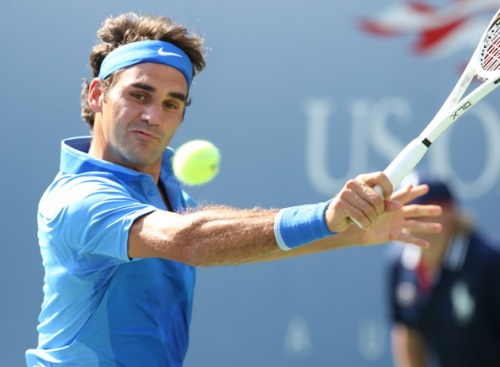Don't miss any stories → Follow Tennis View
FollowMagnificent (Number) Seven: Roger Federer Eases Into Round Three
Many headlines have swirled around Roger Federer this summer, few of them favorable. Mixed results in the clay season did not come as a shock, but a second-round upset at Wimbledon did. Then came a loss to a qualifier in Hamburg, a tournament where Federer always has fared well, and an opening-round loss on home soil in Switzerland. A subplot concerned his failed experiment with a larger racket, ditched before he withdrew from Montreal and suffered yet another loss at the hands of nemesis Rafael Nadal. That defeat in Cincinnati dropped Federer out of the top five for the first time in over a decade.
The world No. 7 thus must have come to New York with his mind fixed on setting the record straight. Federer had advanced comfortably enough in his first match against the overmatched Grega Zemlja, who never forced the Swiss star to find his best form. Argentine clay specialist Carlos Berlocq did not pose a much greater threat on the surface, nor had he ever won a match against a top-10 opponent (0-16). But Berlocq had won a set from Nadal this spring and claimed his first career title this summer.
That breakthrough should have given this Argentine confidence heading into Arthur Ashe Stadium, where Novak Djokovic had demolished him so brutally two years ago. Berlocq’s serve ranks among the most vulnerable in the top 100, a weakness that Federer’s less consistent return exploited almost as relentlessly as Djokovic did.

Entering the court in Mediterranean blue, Federer looked as relaxed as one might expect of someone who has won this tournament five times. Berlocq appeared in a combination of colors similar to top-four men Novak Djokovic and Andy Murray, but the former champion was not fooled. Federer opened the match with one of his vintage one-minute holds at love, which contrasted with Berlocq’s first service game. The Argentine secured it only after a deuce situation, illustrating his disadvantage in that area.
Federer’s forward movement shone more than it did in his opening match as he carved off the crisp volleys that have contributed to his seven Wimbledon titles. Another barometer of his confidence has been the depth and precision of his one-handed backhand. Breaking Berlocq in the fourth game, Federer consolidated the break by ripping that shot down the line for a clean winner. He had run around it to inside-out forehands during the first few games, for which his opponent had punished him. Federer sent a stronger message by using his backhand as a weapon, even striking an outright return winner with it in the next game.
One break usually suffices to earn Federer a set against a journeyman like Berlocq. He held his own serve comfortably throughout the first set, never facing a break point while testing his opponent in each return game. The Argentine could not assert himself as long as this dynamic persisted, for Federer had nothing to fear from across the net and could take risks with impunity. His shots flowed freely in the relaxed atmosphere.
As the 31-minute first set flew past, Berlocq must have felt rushed out of the methodical baseline rhythm that this clay specialist prefers. The fast courts in New York favored Federer’s aggressive attack over the Argentine grinder, and he broke to start the second set. A few wayward groundstrokes then cost him his own serve. With an expression of disgust, Federer flicked the balls across the net and prepared to start afresh. He will know that this sort of service game would have cost him more dearly against an elite opponent.
An elegantly constructed point produced a third straight break of serve. During this exchange, Federer retrieved a series of well-placed volleys by Berlocq before a deft lob set up the point-ending smash. A love hold consolidated the break, and the wheels started to come off the underdog’s game. Broken or at deuce in every service game through the first set and a half, Berlocq understandably crumbled under the pressure. An insurance break allowed Federer to close out the second set. He delighted the crowd with a tweener from well behind the baseline, although he eventually lost the point.
After 73 minutes, Federer led by two sets and a break as Berlocq’s shoulders sagged in recognition of the inevitable. The Swiss maestro faced another break point in the fourth game, but he held firm before finishing off a resounding 6-3 6-2 6-1 victory.
The competition may grow a little stiffer for Federer in the third round against second-ranked American man Sam Querrey. But Federer never has lost a set to Querrey and should feel confident of reaching the second week without much ado. As a marquee quarterfinal against Rafael Nadal edges closer, he will benefit from efficient wins that allow him to conserve energy.










